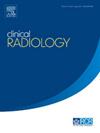Radiomics analysis based on 18F-fluorodeoxyglucose positron emission tomography/computed tomography for differentiating the histological classification of peripheral neuroblastic tumours
IF 2.1
3区 医学
Q2 RADIOLOGY, NUCLEAR MEDICINE & MEDICAL IMAGING
引用次数: 0
Abstract
Aim
To create a radiomics nomogram based on 18F-fluorodeoxyglucose positron emission tomography/computed tomography and assess the efficacy of this nomogram in differentiating ganglioneuroblastoma from neuroblastoma in peripheral neuroblastic tumours (PNTs).
Materials and Methods
One hundred and ninety-nine patients with PNTs were retrospectively included, including 115 neuroblastoma patients and 84 ganglioneuroblastoma patients, who were randomly split into the training and test sets according to a ratio of 7:3. The 3D slicer was used to delineate the primary tumour, then radiomics features were extracted and selected, and a radiomics model was built using the optimal radiomics features. The clinical model was constructed from independent clinical risk factors. A radiomics nomogram was developed by multivariate logistic regression analysis incorporating independent clinical risk factors and radiomics features. Model performance was assessed using receiver operating characteristic curves and decision curve analysis.
Results
The radiomics model based on the selection of 14 radiomics features was developed. The clinical model was constructed by combining age at diagnosis and 1p aberrations. The radiomics nomogram demonstrated the optimal diagnostic value in distinguishing between ganglioneuroblastoma and neuroblastoma, with an area under the receiver operating characteristic curve of 0.857 and 0.795 in the training and test sets, respectively. The decision curve analysis and calibration curves also showed good performance for the nomogram.
Conclusions
The radiomics nomogram could improve diagnostic performance by differentiating the histological classification of PNTs.
求助全文
约1分钟内获得全文
求助全文
来源期刊

Clinical radiology
医学-核医学
CiteScore
4.70
自引率
3.80%
发文量
528
审稿时长
76 days
期刊介绍:
Clinical Radiology is published by Elsevier on behalf of The Royal College of Radiologists. Clinical Radiology is an International Journal bringing you original research, editorials and review articles on all aspects of diagnostic imaging, including:
• Computed tomography
• Magnetic resonance imaging
• Ultrasonography
• Digital radiology
• Interventional radiology
• Radiography
• Nuclear medicine
Papers on radiological protection, quality assurance, audit in radiology and matters relating to radiological training and education are also included. In addition, each issue contains correspondence, book reviews and notices of forthcoming events.
 求助内容:
求助内容: 应助结果提醒方式:
应助结果提醒方式:


